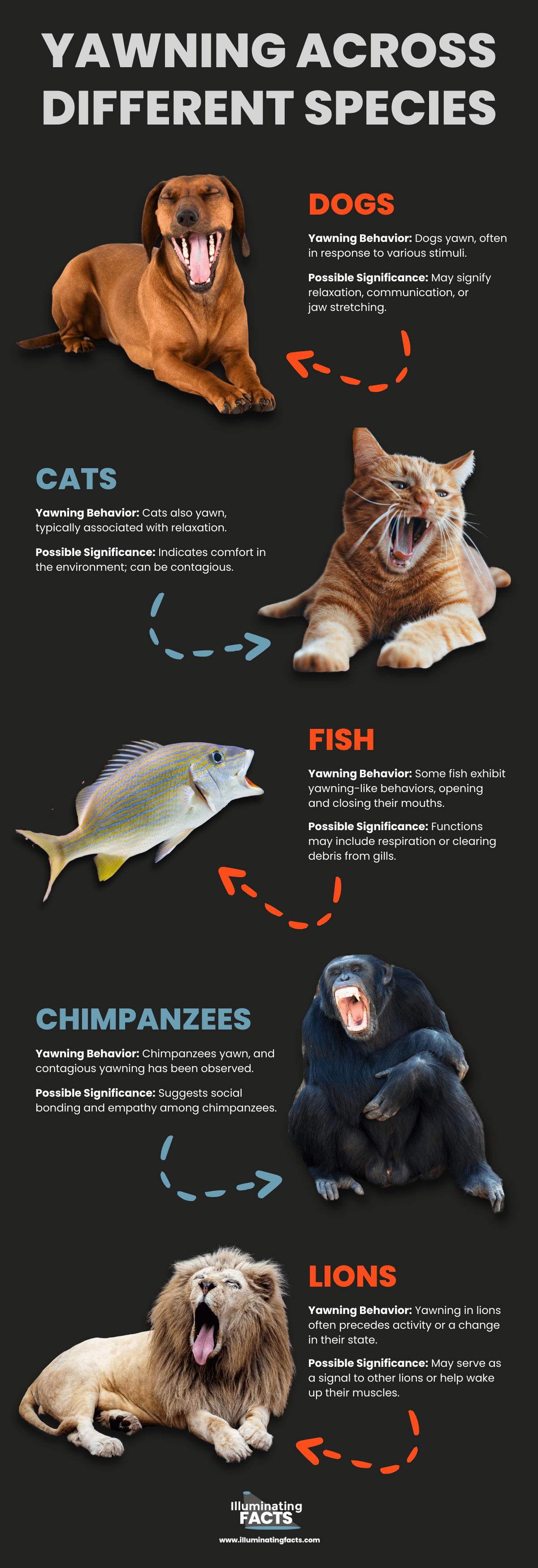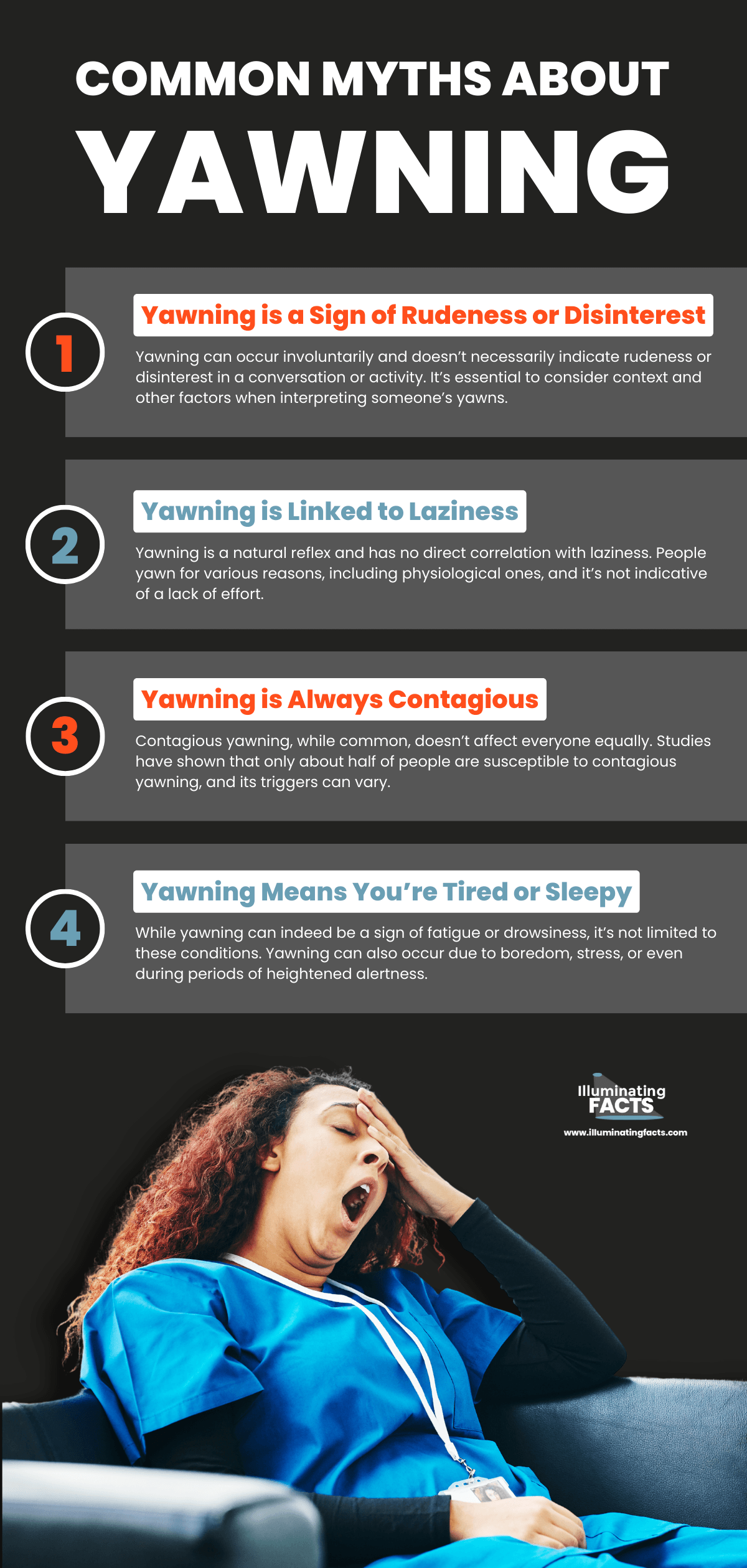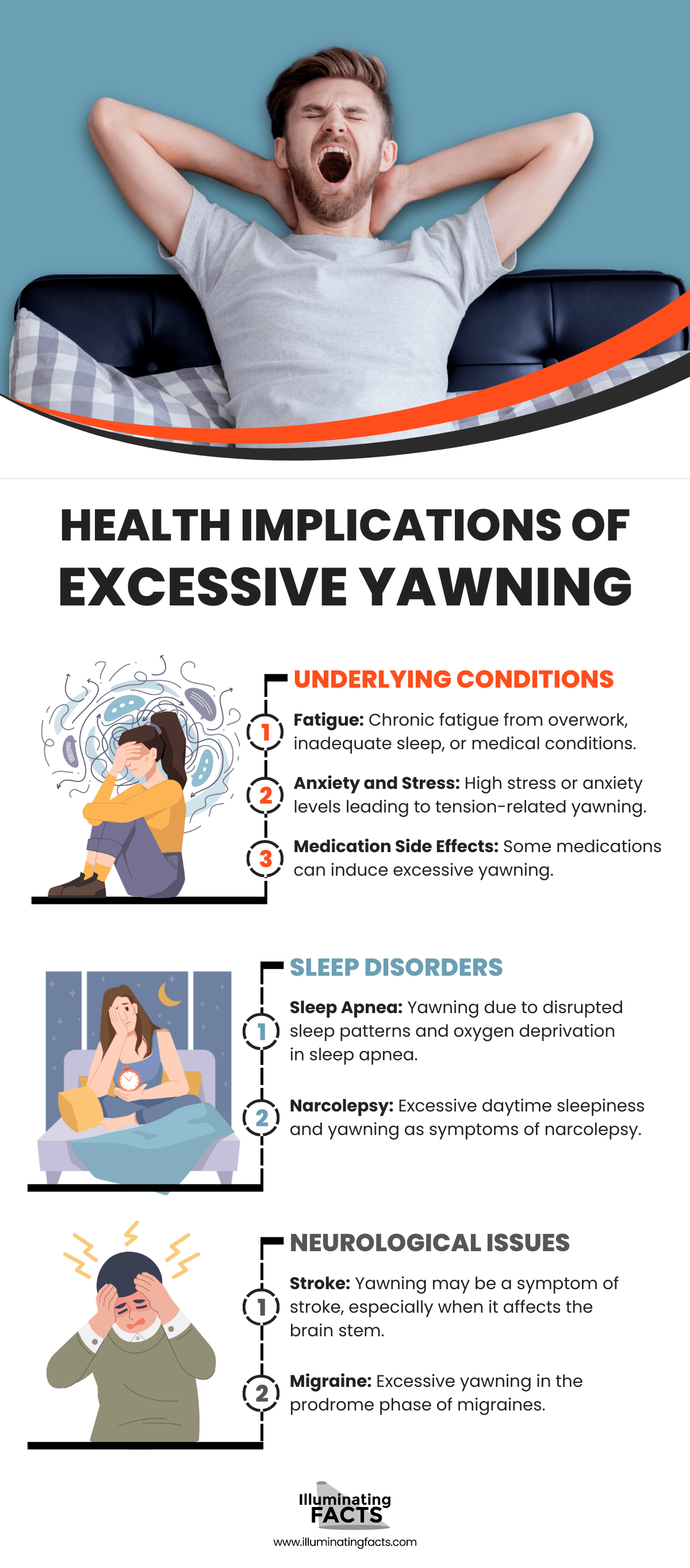Yawning is a universal phenomenon observed in humans and animals alike. It is a seemingly simple act that has intrigued scientists and philosophers for centuries. This involuntary reflex involves opening one’s mouth wide, taking a deep breath, and letting out a satisfying exhale. Despite its common occurrence, the exact purpose and mechanisms behind yawning continue to be subjects of scientific investigation.
This article delves into the phenomenon of yawning, shedding light on the underlying processes and exploring why it remains a fascinating topic of study. By gaining insights into yawning, we uncover a deeper understanding of our bodies and the mysteries that lie within.
The Anatomy of a Yawn
Often considered a simple and involuntary act, yawning unfolds a fascinating sequence of physiological events. During a yawn, our bodies engage in a series of deliberate actions. It starts from the wide opening of the mouth ending in the deep inhalation of air. Understanding the anatomy of a yawn reveals the intricacies of this reflex.
What Physically Happens When You Yawn
Yawning involves a sequence of physical actions that occur with remarkable consistency:
Mouth Opening
Yawning typically begins with the mouth opening wide. This action allows for increased airflow into the respiratory system.
Deep Inhalation
The most distinctive feature of a yawn is the deep breath. The amount of air you take in during a yawn is significantly larger than during normal breathing. This deep breathing action fills your lungs with oxygen-rich air, replenishing the oxygen levels in your body. [1]
Stretching of Facial Muscles
The mouth opening during a yawn involves stretching of the facial muscles. Particularly those around the jaw and mouth. This stretching action helps expand the mouth further and facilitates deep inhalation. It engages a network of muscles, including those controlling the jaw, face, and throat. This coordinated effort is essential for the yawning reflex.
However, contrary to the popular belief yawning is not linked to oxygen deficiency. Some more recent studies show other explanations. [2]
Muscle Group | Function | Specific Muscles | Specific Function |
Jaw Muscles | Responsible for jaw movement and mouth opening. | Masseter | Responsible for closing the jaw during chewing and clenching. |
Temporalis | Assists in jaw movement, including jaw closure and retraction. | ||
Pterygoids | Help control the side-to-side movement of the jaw, contributing to mouth opening. | ||
Facial Muscles | Involved in facial expressions and lip movement. | Orbicularis Oris | Encircles the mouth and is essential for controlling lip movements and closing the mouth. |
Zygomaticus | Involved in facial expressions, particularly smiling, by lifting the corners of the mouth. | ||
Throat and Neck Muscles | Assist in neck movement and jaw support. | Digastric | Helps with jaw movement and swallowing |
Sternocleidomastoid | Assist in tilting the head backward, forward, or to the side | ||
Respiratory Muscles | Control breathing and deep inhalation. | Diaphragm | Contracts to create a vacuum in the chest cavity, allowing air to be drawn into the lungs during inhalation |
Intercostal Muscles | Contribute to chest expansion during breathing and assist in deep inhalation |
The Science Behind Yawning
While yawning is a common and seemingly simple act, the science that underlies this reflex is anything but ordinary. Yawning engages a web of intricate neurological processes, intriguing researchers and scientists for generations. Let’s delve into the scientific aspects of yawning.
Neurological Aspects
Yawning is not just a simple reflex. It involves complex neurological processes such as:
Brain Activation
| Brain Region | Role in Yawning |
| Hypothalamus | Regulates sleep cycles and overall alertness. |
| Sleep-Wake Control | Influences transitions between wakefulness and rest. |
| Autonomic Nervous System | Modifies autonomic functions briefly. |
| Neural Networks | Complex interactions between neurotransmitters, brain regions, and neural pathways contribute to the yawning reflex. |
The phenomenon of yawning goes beyond a mere reflex; it involves notable brain activation:
Hypothalamus: The hypothalamus is a small but vital region deep within the brain. When you yawn, the hypothalamus experiences heightened activity, potentially influencing your level of alertness. [3]
Sleep-Wake Regulation: Yawning is intertwined with the brain’s efforts to regulate the sleep-wake cycle. When we yawn, our brain initiates processes to either wake us up or prepare us for rest. [4]
Autonomic Nervous System: Yawning is also linked to changes in the autonomic nervous system. The act of yawning may briefly shift the balance of the autonomic nervous system, potentially impacting the overall physiological state. [5]
Neural Networks: Yawning doesn’t occur in isolation but is interconnected with various neural networks. These networks involve intricate interactions between neurotransmitters, brain regions, and neural pathways. [6]
Role of Neurotransmitters
Neurotransmitters, the brain’s chemical messengers, are implicated in yawning too.
| Neurotransmitter | Role in Yawning |
| Dopamine | Linked to reward and motivation. Changes in dopamine levels may influence yawning frequency, but the exact mechanism is still under study. |
| Serotonin | Associated with drowsiness. Low serotonin levels may contribute to yawning, possibly as a mechanism to increase alertness. |
The Brain Cooling Theory
One intriguing hypothesis surrounding yawning is the brain cooling theory. This theory suggests that yawning serves as a mechanism to regulate brain temperature. [7] Although the precise mechanisms are still under investigation, the theory provides valuable insights into why we yawn.
Temperature Regulation
The brain is exceptionally sensitive to temperature changes. When you yawn, you draw in a deep breath of cooler air. This air intake is said to have a cooling effect on the blood flow in the brain, helping it regulate its temperature.
Enhanced Alertness
Cooling the brain through yawning may have the beneficial side effect of enhancing alertness. By maintaining the brain’s optimal temperature, this reflex could assist in ensuring that cognitive functions operate efficiently, thus contributing to increased wakefulness.
Frequency Variation
Some studies have suggested that yawning frequency may vary with environmental temperatures. [8] Yawning may occur more frequently in warmer conditions, aligning with the idea that it helps regulate brain temperature in response to external factors.
Contagious Yawning
When one person yawns, it often triggers a yawn in others nearby. [9] This intriguing phenomenon, known as contagious yawning, holds insights into our social bonds and the fascinating workings of our brains.
Why Yawning is Contagious
Contagious yawning, an everyday occurrence, isn’t merely a coincidence. It’s linked to theories of social bonding and our brain’s mirror neuron system.
Social Bonding Theory
One theory suggests that it is linked to social bonding. [10] When we see someone yawning, especially someone we are emotionally connected to, it triggers a subconscious response. It may serve as a nonverbal signal of empathy and social cohesion.
Mirror Neurons
Mirror neurons, a class of brain cells, play a significant role in contagious yawning. [11] These neurons are involved in imitating and empathizing with others. When we observe someone yawning, our mirror neurons activate, leading us to yawn in response.
Facts and Figures
- Studies indicate that approximately 40% to 60% of people are susceptible to contagious yawning. [12]
- Contagious yawning isn’t exclusive to humans. Some animal species, including chimpanzees, dogs, and even budgerigars (parakeets), have demonstrated susceptibility to contagious yawning. [13]
Yawning Across Different Species
Yawning or yawning-like behaviors have been observed in a variety of animal species. Photographers have been capturing the perfect moment in wildlife photography since forever. These include photos of mammals, birds, and even some fish. While the exact count of species that yawn isn’t precise, it underscores the widespread nature of this behavior in the animal kingdom.
Animal Species | Yawning Behavior | Possible Significance |
Dogs | Dogs yawn, often in response to various stimuli. | May signify relaxation, communication, or jaw stretching. |
Cats | Cats also yawn, typically associated with relaxation. | Indicates comfort in the environment; can be contagious |
Fish | Some fish exhibit yawning-like behaviors, opening and closing their mouths. | Functions may include respiration or clearing debris from gills. |
Chimpanzees | Chimpanzees yawn, and contagious yawning has been observed. | Suggests social bonding and empathy among chimpanzees. |
Lions | Yawning in lions often precedes activity or a change in their state. | May serve as a signal to other lions or help wake up their muscles. |
Similarities and Differences with Human Yawning
Across different species, yawning shares some similarities with human yawning, such as mouth opening and stretching. However, the specific triggers and functions of yawning can vary significantly between species.
Aspect | Similarities | Differences |
Mouth Opening | Both animals and humans often exhibit wide mouth opening during yawning. | The duration and extent of mouth opening may vary between species. |
Stretching | Yawning involves stretching of certain muscles, observed in both animals and humans. | The specific muscles involved and the degree of stretching may differ. |
Trigger Factors | Yawning can be triggered by various factors, such as tiredness or relaxation. | The specific triggers for yawning can vary widely among species. |
Communication | In some cases, yawning may serve as a form of communication or social bonding. | The communicative aspects of yawning differ among species. |
Neurological Mechanisms | Yawning often involves neurological mechanisms, including mirror neurons. | The exact neurological processes and their role may vary. |
Social Contagion | Contagious yawning occurs in both humans and some animals. | The susceptibility and triggers for contagious yawning can differ. |
Common Myths About Yawning
Yawning is a Sign of Rudeness or Disinterest: Yawning can occur involuntarily and doesn’t necessarily indicate rudeness or disinterest in a conversation or activity. It’s essential to consider context and other factors when interpreting someone’s yawns.
Yawning is Linked to Laziness: Yawning is a natural reflex and has no direct correlation with laziness. People yawn for various reasons, including physiological ones, and it’s not indicative of a lack of effort.
Yawning is Always Contagious: Contagious yawning, while common, doesn’t affect everyone equally. Studies have shown that only about half of people are susceptible to contagious yawning, and its triggers can vary.
Yawning Means You’re Tired or Sleepy: While yawning can indeed be a sign of fatigue or drowsiness, it’s not limited to these conditions. Yawning can also occur due to boredom, stress, or even during periods of heightened alertness.
Health Implications of Excessive Yawning
Health Implication | Possible Issue | Description |
Underlying Conditions | Fatigue | Chronic fatigue from overwork, inadequate sleep, or medical conditions. |
Anxiety and Stress | High stress or anxiety levels leading to tension-related yawning. | |
Medication Side Effects | Some medications can induce excessive yawning. | |
Sleep Disorders | Sleep Apnea | Yawning due to disrupted sleep patterns and oxygen deprivation in sleep apnea. |
Narcolepsy | Excessive daytime sleepiness and yawning as symptoms of narcolepsy. | |
Neurological Issues | Stroke | Yawning may be a symptom of stroke, especially when it affects the brain stem. |
Migraine | Excessive yawning in the prodrome phase of migraines. |
Interesting Facts
- Yawning is one of the oldest recorded human behaviors, with depictions found in art and literature since ancient times to modern ages. [14]
- Yawning is not only contagious among humans but also between humans and some animals like dogs. [15]
- The thermoregulatory theory suggests that yawning helps to cool down the brain, improving alertness and mental efficiency. [16]
- Yawning is not solely an indicator of sleepiness or boredom; it can also be a sign of stress or excitement. [17]
- Fetuses in the womb have been observed yawning as early as 11 weeks into the pregnancy. [18]
- Yawning does not significantly alter levels of oxygen in the blood. [19]
- Some theories propose that yawning evolved as a social bonding mechanism, especially among primates. [20]
- Yawning is more likely to occur when the temperature is cooler. [21]
- Children are less likely to “catch” a yawn than adults. [22]
- Excessive yawning can be a symptom of certain medical conditions, including sleep disorders, migraines, and even heart issues. [23]
Conclusion
Yawning, a seemingly simple reflex, holds a fascinating array of facets. While commonly associated with tiredness, it can also signal stress, boredom, or even empathy in response to others. Yawning extends its enigma across various species, from humans to animals, reflecting shared and distinct behaviors.
Yet, when excessive, yawning may reveal underlying health concerns, from fatigue and anxiety to sleep disorders and neurological issues. It is a subtle signal from our bodies, urging us to pay attention to our well-being.
References
- Excessive yawning is telling you about these health dangers. (2018, June 18). The Times of India. https://www.google.com/amp/s/m.timesofindia.com/life-style/health-fitness/photo-stories/excessive-yawning-is-telling-you-about-these-health-dangers/amp_etphotostory/64634397.cms
- Yawning and its physiological significance. (2013, January). PubMed Central (PMC). https://www.ncbi.nlm.nih.gov/pmc/articles/PMC3678674/
- Why do we yawn? (2019., November 19). The Library of Congress. https://www.loc.gov/everyday-mysteries/biology-and-human-anatomy/item/why-do-we-yawn/
- Connectivity of sleep- and wake-promoting regions of the human hypothalamus observed during resting wakefulness. (2018, May 29). OUP Academic. https://academic.oup.com/sleep/article/41/9/zsy108/5021065
- Inhibition of muscle sympathetic nerve activity during yawning. (n.d.). PubMed. https://pubmed.ncbi.nlm.nih.gov/8902321/
- Yawning-its anatomy, chemistry, role, and pathological considerations. (n.d.). PubMed. https://pubmed.ncbi.nlm.nih.gov/29197651/
- Yawning-its anatomy, chemistry, role, and pathological considerations. (n.d.). PubMed. https://pubmed.ncbi.nlm.nih.gov/24721675/
- Changes in ambient temperature trigger yawning but not stretching in rats. (21, November). PubMed Central (PMC). https://www.ncbi.nlm.nih.gov/pmc/articles/PMC2995215
- Why yawns are contagious—in all kinds of animals. (n.d.). https://www.science.org/content/article/why-yawns-are-contagious-all-kinds-animals
- Yawning may promote social bonding even between dogs and humans. (2017, May 15). NPR. https://www.npr.org/sections/health-shots/2017/05/15/527106576/yawning-may-promote-social-bonding-even-between-dogs-and-humans
- Mirror Neuron activity during contagious yawning–an fMRI study. (n.d.). PubMed. https://pubmed.ncbi.nlm.nih.gov/22772979/
- Just a moment… (n.d.). Just a moment… https://journals.sagepub.com/doi/full/10.1177/2041669517726797#body-ref-bibr48-2041669517726797-3
- Thompson, H. (2014, August 27). Yawning spreads like a plague in wolves. Smithsonian Magazine. https://www.smithsonianmag.com/science-nature/yawning-spread-plague-wolves-180952484/
- Popular knowledge and beliefs. (n.d.). Karger Publishers. https://karger.com/books/book/2691/chapter/5762384/Popular-Knowledge-and-Beliefs
- Animals: Yawning is catching – and not just for humans. (2008, August 5). the Guardian. https://www.google.com/amp/s/amp.theguardian.com/science/2008/aug/06/animalbehaviour
- A thermal window for yawning in humans: Yawning as a brain cooling mechanism. (n.d.). PubMed. https://pubmed.ncbi.nlm.nih.gov/24721675/
- Nast, C. (2017, July 21). Why do we yawn? It could mean you’re ‘highly aroused’. WIRED UK. https://www.wired.co.uk/article/why-do-we-yawn
- On hiccuping and yawning: why we do it. (1999, January 1). nature.com . https://www.nature.com/articles/gim199984
- Yawning: No effect of 3-5% CO2, 100% O2, and exercise. (n.d.). PubMed. https://pubmed.ncbi.nlm.nih.gov/3120687/
- Yawns more contagious among friends. (2011, December 8). NBC News. https://www.nbcnews.com/health/body-odd/yawns-more-contagious-among-friends-flna1c6436895
- Winter brings more yawns than summer, study claims. (2011, September 28). NBC News. https://www.nbcnews.com/health/body-odd/winter-brings-more-yawns-summer-study-claims-flna1c6436950
- Babies and young children are immune from ‘catching’ yawns. (2010, December 4). The Telegraph. https://www.telegraph.co.uk/news/newstopics/howaboutthat/8181444/Babies-and-young-children-are-immune-from-catching-yawns.html
- Excessive yawning causes & treatment. (n.d.). Baptist Health. https://www.baptisthealth.com/care-services/conditions-treatments/excessive-yawning








